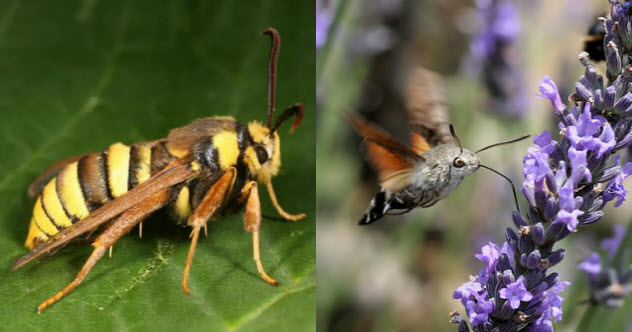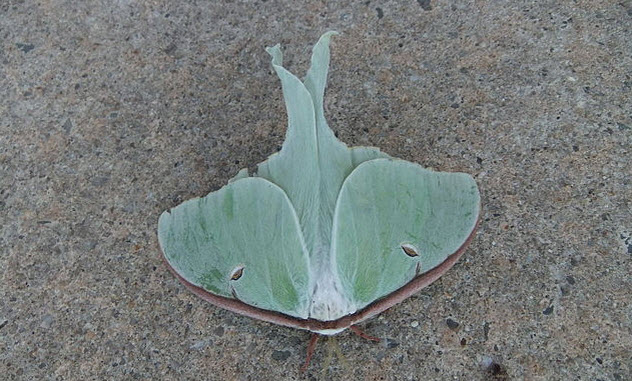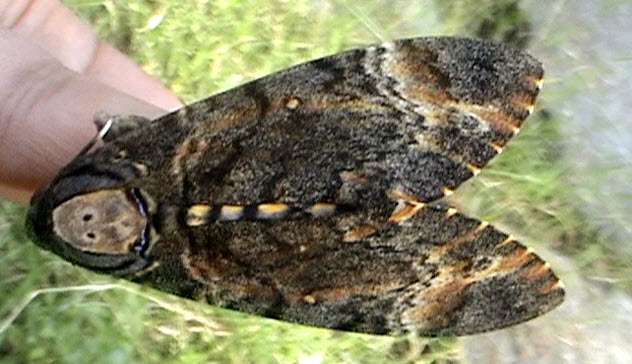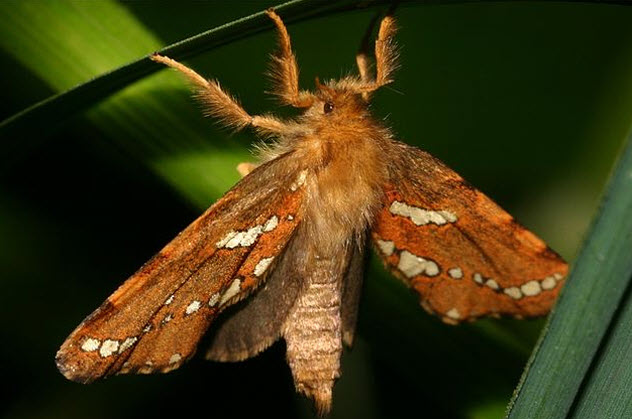 History
History  History
History  Weird Stuff
Weird Stuff 10 Superstitious Beliefs That Once Consumed Entire Cultures
 History
History 10 Bizarre Friendly Fire Incidents in Military History
 Technology
Technology 10 Modern Technologies That Accidentally Imitate Ancient Magic
 Mysteries
Mysteries 10 Mysteries of the Human Genome
 Weird Stuff
Weird Stuff 10 Things So Rare They’ve Only Been Found Once
 History
History 10 Legends Whose Last Moments Undid Their Glory
 Health
Health 10 Futuristic Ideas to Treat Common Medical Problems
 Weird Stuff
Weird Stuff Ten Surreal Attempts to Reverse Baldness
 Facts
Facts 10 U.S. Government Contingency Plans for the Unthinkable
 History
History 10 Odd Things Colonial Americans Kept at Home
 Weird Stuff
Weird Stuff 10 Superstitious Beliefs That Once Consumed Entire Cultures
 History
History 10 Bizarre Friendly Fire Incidents in Military History
Who's Behind Listverse?

Jamie Frater
Head Editor
Jamie founded Listverse due to an insatiable desire to share fascinating, obscure, and bizarre facts. He has been a guest speaker on numerous national radio and television stations and is a five time published author.
More About Us Technology
Technology 10 Modern Technologies That Accidentally Imitate Ancient Magic
 Mysteries
Mysteries 10 Mysteries of the Human Genome
 Weird Stuff
Weird Stuff 10 Things So Rare They’ve Only Been Found Once
 History
History 10 Legends Whose Last Moments Undid Their Glory
 Health
Health 10 Futuristic Ideas to Treat Common Medical Problems
 Weird Stuff
Weird Stuff Ten Surreal Attempts to Reverse Baldness
 Facts
Facts 10 U.S. Government Contingency Plans for the Unthinkable
Top 10 Insane Moth Facts That Will Blow Your Mind
You thought that moths were boring, right? Well, think again. From emitting sonar-scrambling ultrasonic clicks to practicing delicious, pineapple-scented Kama Sutra, the true awesomeness of moths goes above and beyond anything that you previously imagined.
10 One Moth Looks So Much Like A Fuzzy Pokemon That People Thought It Was A Hoax
This fuzzy white moth looks so bizarre that when its pictures first hit the Internet in 2009, it was passed off as a hoax. But it has since been proven to be a genuine moth of an unconfirmed species that was photographed by zoologist Dr. Arthur Anker in 2009.
Anker’s photographs have been verified as authentic by Dr. Karl Shuker, a world-renowned zoologist, science writer, and cryptozoologist. When news of this bizarre-looking fellow first reached Shuker in 2012, he made it his personal mission to determine if the image was authentic or a Photoshop hoax.
Shuker eventually tracked down Anker. Shuker also found Anker’s photos of the poodle moth and many other Venezuelan insect species on Anker’s Flickr page. As far as Anker knows, he is the only person who has ever photographed this fascinating-looking moth and no other zoologist has been able to identify it. Anker coined the term “poodle moth” because it had no official name.
There is still much debate as to this moth’s species. But Shuker points out that all attempts to identify it are strictly opinions until scientists have an actual specimen—preferably a living one.
9 Some Moths Look Nothing Like Moths

Generally, one expects a moth to be some drab variation of brown. However, many moths display brightly colored murals on their wings, and some even look like a different species entirely.
One of the stranger variations is the hornet moth. This moth (Sesia apiformis) has harnessed the power of Batesian mimicry. To predators, it appears to have the natural defenses of a hornet even though the hornet moth is completely harmless. This scares off predators that don’t want to tangle with a stinging insect.
In addition to mimicking the color patterns of a hornet, the hornet moth has developed transparent wings (which are not common for moths) and replicates the jerky movements of a hornet when in flight.
Another strange variation of moth, the hummingbird hawkmoth, is believed to be an example of convergent evolution. This means that two separate species developed similar biological traits to facilitate their survival within a certain ecological niche.
The hummingbird hawkmoth has a long sucker (proboscis) which it uses to suck nectar from flowers. This proboscis resembles the beak or tongue of a hummingbird when seen from a distance. Like a hummingbird, this moth hovers and moves its wings so fast that they appear as an orange blur.
Although many moths are nocturnal, this one is happy to go about its business during the daylight hours. As it hovers, it also makes a humming sound, just like the sound that gives the hummingbird its name.
8 Auditory Deflection And Expendable Body Parts

The luna moth is well-known for its beautiful appearance and its pale green translucent glow. However, the luna moth doesn’t make its own light. Instead, it has scales on its wings that reflect moonlight or other sources of light.
Luna moths can’t eat because they don’t have mouths. With a one-week life span, they only have one purpose: reproduction. But first, they have to avoid being munched to death by a hungry bat.
For over 60 million years, bats and moths have been locked in an evolutionary arms race in which each constantly adapts to outsmart the other.
Bats hunt in the dark by echolocation, forming a visual image to locate their prey based on the quality of the echoes that bounce back to them when they release sonar calls (high-pitched squeaks). The fluttering wings of a moth give off a distinct echo, which is like a dinner bell to a hungry bat. There is no way for a flying moth to prevent this echo.
However, recent studies have shown that the long elegant tails on the luna moth’s hind wings spin as the moth flies, causing distorted echoes to bounce back to the bats. A bat will often completely miss the moth or only get a mouthful of tail wing as a result of the moth’s spinning wing tails.
This is called auditory deflection. It works like the visual deflection of bright eyespots on a butterfly’s wings which direct attacking predators away from essential parts of the butterfly’s body.
The luna moth’s wing tails are completely expendable. Their loss does not affect the moth’s ability to fly in any way. More importantly, they give the moth a second chance at achieving its life purpose: sex.
7 Tears For Dinner, Anyone?
Many moths feed on the tears of large animals such as deer, crocodiles, and elephants. In fact, some moths feed on blood.
In 2004, scientists discovered that Hemiceratoides hieroglyphica, a Madagascan moth species, feeds on the tears of sleeping birds. As compared to the soft, easily penetrated eyelids of larger animals, birds have two eyelids and a protective membrane that must be pierced before access can be gained to those delicious, salty tears.
So how does Hemiceratoides hieroglyphica manage this? Its proboscis (unlike the soft proboscises of moths that feed on larger animals) is a tiny armory of sharp barbs, spines, and hooks.
Hemiceratoides hieroglyphica uses the tip of its proboscis, which is shaped like an ancient harpoon, to pierce the bird’s eyelid. With the barbs, the moth anchors its proboscis into a feeding position while the moth sits on the bird’s neck. It can feed this way for up to 30 minutes.
Scientists speculate that the moth may spit anesthetic into the eyelid of the bird to prevent it from waking up and eating the moth for dinner.
6 A Noisy Thief That Uses Chemical Camouflage

Most people know of the death’s-head hawkmoth from the The Silence of the Lambs. Although famous for the distinctive skull-like patterns on its thorax, this moth has other cool characteristics. The death’s-head likes to steal honey directly from fully guarded, occupied beehives, a feat that would be deadly for almost any other insect.
To invade a beehive, the death’s-head must first get past ferocious guards that will generally attack and kill anything that attempts to enter the hive. The death’s-head achieves entry by raising its body and screeching loudly. Apparently, this screeching produces a calming effect that makes the guards and worker bees less likely to attack.
A thick cuticle and relative immunity to bee venom helps to protect the death’s-head against any bees who aren’t as susceptible to the screeching. So the moth can acquire multiple stings during its risky entry into the hive, but usually, little damage is sustained.
Worker bees normally swarm any intruder that gets past the guards, sting the intruder to death, and give up their own lives in the process. However, the death’s-head passes hundreds of workers relatively unheeded by cloaking itself in a chemical camouflage.
It’s a type of invisibility cloak that is created by mimicking the scent of the worker bees. As a result, they cannot distinguish the scent of the moth from the other worker bees.
The moth continues to squeak loudly during its honey raid. According to one popular theory, the moth is mimicking the queen bee’s command to become passive, making the worker bees less likely to attack.
Mistakes do happen, and death’s-heads are often found stung to death in commercial beehives. But for the most part, the death’s-head hawkmoth is the ultimate, albeit noisy, thief in the night.
5 How Could A Moth Influence Where A Sloth Poops?
For years, scientists have been baffled by the fact that slow-moving, relatively defenseless, half-blind, half-deaf three-toed sloths descend from the safety of their treetops once a week to defecate on the ground, where they are extremely vulnerable to practically every predator imaginable.
Over half of all sloth deaths occur during their weekly toilet visits. So why don’t they poop from the safety of the tree canopy? And how could a humble moth have anything to do with this?
A sloth is like a miniature ecosystem. Its fur contains algae gardens, fungi, and mites found nowhere else. The hair of a sloth is designed to catch rainwater, which keeps its algae gardens moist and fresh.
The sloth moth (aka Cryptoses choloepi) is also found only in the fur of sloths. Scientists presume that this moth feeds on the sloth’s skin secretions or the algae living in its fur. The moth also lays its eggs exclusively in the sloth’s poop.
As the sloth defecates, the moths climb out of its fur and lay eggs in its dung. The eggs hatch into caterpillars that feed off the sloth’s poop until they develop into adult moths and fly off to colonize other sloths.
Jonathan Pauli, an expert in wildlife ecology, has hypothesized that moths and sloths have a mutually beneficial arrangement that makes a sloth willing to risk its life to cultivate the moth’s eggs.
According to Pauli’s theory, the algae that live in the sloth’s fur somehow feed off the moths—either on the nitrogen released by the moths when they die or on the sloth dung stuck to their bodies.
In turn, the sloths somehow rely on the algae as a vital source of nutrients that they cannot obtain from their diet of leaves.It’s also believed that the sloth relies on the algae as a green-hued camouflage that helps to protect it from predators.
Others have argued that a sloth has never been seen licking its fur, so it’s unlikely that the sloth obtains nutritional benefits from the algae. Yet Pauli hypothesizes that nutrients could potentially be absorbed through the sloth’s skin from secretions made by the algae.
4 Moth Kama Sutra With A Hint Of Pineapple

Mating for most moth species is fairly simple. The female stays still and gives off a pheromone scent. The nearest male smells it and mates with her. Done. Not so with gold swift moths. They are believed to have the most elaborate mating rituals in the entire insect kingdom.
Males of this species often gather into a group called a lek. There, they sit around looking pretty and dangle yellow scent brushes which give off a smell of ripe pineapple. The sweet-smelling pheromone attracts females who choose their mate from the males in the lek.
Sometimes, the female just basks in the sun, flutters her wings flirtatiously, and emits her own pheromones. Then she chooses a mate from the group of males that come to her.
The moths may also dance around each other in groups and begin to copulate in midair. This varied array of courtship patterns can confuse the males, who sometimes end up trying to copulate with each other by mistake.
Once mating begins, the moths choose from a number of flexible positions that usually end with the male hanging upside down from the female’s abdomen while the two are attached at the genitals. They can also mate face to face or back to front.
While mating, the moths have to remain completely still to avoid being spotted and eaten. Unless thwarted, this procedure will last the entire night.
3 Epic Puddler Anal Jets
Moths congregate around fluids, around dung, and even around decaying flesh. This behavior is called puddling.
Mostly, the males of the species partake in this activity, spending hours greedily guzzling their preferred fluids. One moth, Gluphisia septentrionis, takes this behavior to the extreme by shooting massive jets of water out of its anus.
Many moths engage in this behavior because they need sodium. They don’t get enough from their regular diets to stay alive and reproduce. So the moths drink fluids to absorb sodium into their abdomens like a sponge. Then they squirt the filtered water out of their anuses.
Gluphisia septentrionis is able to consume and squirt out around 20 jets of water per minute. Each jet reaches about 0.3 meters (1.0 ft) in length. Scientists saw one moth expel 4,325 jets of water in 3.4 hours, which was 600 times its body mass.
The male passes on around half of his sodium reserves to a female during courtship. In turn, she passes the salt to her offspring to ensure healthy larvae. Researchers jokingly call this “salting their eggs.”
2 Slow-Motion Brain
Even though moths can drink nectar from a moving flower while hovering in midair, challenges arise when an insect that relies on sight is trying to do this in the dark.
Enter Manduca sexta, a species of hawkmoth, which has the amazing ability to slow down its own brain. This spectacular feat allows the hawkmoth to see better in low light while maintaining its ability to hover like a hummingbird and track the movements of its favorite flowers.
The process works like a slower shutter speed in a camera. This allows the moth’s brain to gather more light, which is then exposed to the visual system for a longer period of time.
This also reduces the moth’s reaction time greatly. However, in a perfect adaptation to the environment, the moth’s ability to hover only slows to the maximum speed at which its preferred flowers are moving. By slowing down its brain, the moth maintains its ability to feed from and pollinate its preferred flowers, even in the pitch black of a windy night.
1 Ultrasonic Genitals
Moths are one of the main food sources for bats, which are the most sophisticated acoustic hunters in the animal kingdom. But the tiger moth has developed the amazing ability to scramble bat sonar signals using the highly developed ultrasound emitters in its thorax (the part between the head and the abdomen).
When the tiger moth hears the sonar call emitted by the bat, the moth precisely times its response, which consists of an emission of ultrasonic clicks. These clicks jam the bat’s sonar squeaks, confusing the bat and rendering it temporarily “blind.” This gives the moth time to escape.
Three species of hawkmoth also emit ultrasonic, sonar-scrambling signals by rubbing their genitals when they hear an approaching bat. Scientists believe that the signals either ward off the bats by warning of the sharp barbs on the hawkmoth’s legs or confuse the bat long enough for the moth to escape.
+ The Hamster With Wings
The Rhodinia fugax (aka the squeaking silk moth) is so fuzzy that it resembles a tiny, winged hamster. The caterpillars of this species squeak. Even more awesome, the pupae squeak inside their cocoons.
If you touch or disturb the cocoon, it will squeak loudly at you. With a wide opening at the top, the cocoon looks like leaves that are wound around the caterpillars inside.
Although water pours into the opening when it rains, the caterpillar includes a drainage hole in the bottom of the cocoon during the weaving process. This ensures that the cocoon won’t flood and drown the pupa inside.
Melita is attempting to do the “social media” thing. Check out her Google+ page if you’d like to see more of her stuff!








